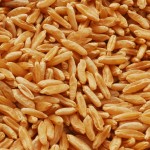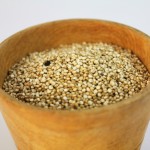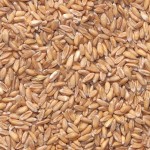by Kayla Richwine
Ancient grains are increasing in popularity as consumers realize their health benefits, tastiness, and ease of addition to traditional dishes. These grains are particularly healthy because they are whole grains. According to the Whole Grains Council, whole grains can reduce the risk of stroke, type II diabetes, asthma, inflammatory disease, and heart disease, as well as maintain healthy weight and blood pressure. As chronic disease instances are rising in modern society, it may be essential to take our diet back to the days of our ancestors and incorporate the grains grown by ancient civilizations into our daily diets.1

Khorasan Wheat (Kamut). This type of wheat is also known as “kamut” which is the ancient Egyptian word for wheat. Kamut contains more protein and vitamin E than durum wheat, the typical modern wheat.2 It is also high in fiber which can help relieve constipation.3
A study performed by researchers in Italy found that a diet rich in Kamut, as compared to a semi-whole wheat diet, resulted in lower total cholesterol, LDL “bad” cholesterol, blood sugar, and pro-inflammatory markers. The diet containing Kamut also showed increased potassium and magnesium levels in the blood.4

Farro. Also called “emmer,” is another variety of wheat. It was commonly used in ancient Italy and some believe that flour made from farro makes the best pasta.2 Farro is also high in fiber which can relieve constipation3 and it contains more antioxidants than many other grains.5
When purchasing farro or products including it, be sure the label says “whole farro,” as opposed to the non-whole grain form called “pearled farro.”2
Spelt. This form of wheat is beneficial because it is a whole grain and it is high in protein. Also, it is similar enough to modern wheat to replace it in most recipes. When purchasing spelt look for the words “whole spelt” on the label to ensure that it is the whole grain version.2
 Quinoa. This ancient crop has rapidly increased in popularity in recent years and can be found in a number of commercial cereals and snack foods. While quinoa is technically related to Swiss chard and beets, it is considered to be a whole grain. It is available in white, purple, red, or black varieties, all of which are whole grains.
Quinoa. This ancient crop has rapidly increased in popularity in recent years and can be found in a number of commercial cereals and snack foods. While quinoa is technically related to Swiss chard and beets, it is considered to be a whole grain. It is available in white, purple, red, or black varieties, all of which are whole grains.
Quinoa is unique because it contains all of the essential amino acids, a rare trait in plant foods. It also contains more potassium than any other whole grain2 and has a much higher antioxidant content than modern durum wheat.6 Quinoa is high in fiber and is gluten-free, making it an important source of whole grains for those with celiac disease.7
 Amaranth. Another gluten-free crop that is not technically a grain but functions similarly and thus, is considered to be a whole grain. It was a common food in ancient Aztec cuisine until it was outlawed. However, amaranth is becoming more well-known today thanks to its many health benefits like its high protein content including all of the essential amino acids.8
Amaranth. Another gluten-free crop that is not technically a grain but functions similarly and thus, is considered to be a whole grain. It was a common food in ancient Aztec cuisine until it was outlawed. However, amaranth is becoming more well-known today thanks to its many health benefits like its high protein content including all of the essential amino acids.8
It may even be able decrease total cholesterol levels as some proteins in amaranth have been shown to inhibit HMG-CoA reductase, an enzyme needed by the body to make cholesterol.9 Researchers in Mexico have also discovered a protein component in amaranth that is believed to prevent some cancers and reduce inflammation.8
Other studies have shown that amaranth seeds soaked in water will produce sprouts that offer even more health benefits. These sprouts contain the essential polyunsaturated fats called linoleic and alpha-linolenic acids, as well as antioxidants.10 Amaranth can be incorporated into the diet by including it in muffins and pancakes, or by purchasing it in cereals and crackers. In South America it is sold popped like popcorn by street vendors. In Mexico this popped amaranth is coated with sugar or honey to make a traditional dessert called “dulce de alegria.”8
While the prevalence of chronic diseases like diabetes and heart disease is on the rise, there are ways to decrease your risk. Eating more whole grains is a simple way, and ancient grains contain added benefits like high protein and mineral contents.
Incorporating ancient grains into your diet is easy. Below are links to healthy recipes made using these grains to help you get started:
- Creamy Chicken and Kamut Casserole
- Kamut, Lentil, and Chickpea Soup
- Farro with Pistachios, Mixed Herbs, and Golden Raisins
- Ancient Grains Cranberry Dark Chocolate Granola
- Dark Chocolate Spelt Waffles
References:
- Wheat – July’s grain of the month. Whole Grains Council Web site. http://wholegrainscouncil.org/whole-grains-101/wheat-july-grain-of-the-month. Updated 2013. Accessed 2016.
- Whole grains A to Z. Whole Grains Council Web site. http://wholegrainscouncil.org/whole-grains-101/whole-grains-a-to-z. Updated 2013. Accessed 2016.
- High-fiber nutrition therapy. Academy of Nutrition and Dietetics: Nutrition Care Manual. Accessed 2016.
- Sofi F, et al. Characterization of khorasan wheat (kamut) and impact of a replacement diet on cardiovascular risk factors: Cross-over dietary intervention study. Eur J Clin Nutr. 2013; 67(2):190.
- Giambanelli E, Ferioli F, Koçaoglu B, et al. A comparative study of bioactive compounds in primitive wheat populations from Italy, Turkey, Georgia, Bulgaria and Armenia. J Sci Food Agric. 2013; 93(14):3490-3501.
- Laus MN, Gagliardi A, Soccio M, Flagella Z, Pastore D. Antioxidant activity of free and bound compounds in quinoa (chenopodium quinoa willd.) seeds in comparison with durum wheat and emmer. J Food Sci. 2012; 77(11):C1150-C1155.
- Gluten-free nutrition therapy. Academy of Nutrition and Dietetics: Nutrition Care Manual. Accessed 2016.
- Amaranth – May’s grain of the month. Whole Grains Council Web site. http://wholegrainscouncil.org/whole-grains-101/amaranth-may-grain-of-the-month-0. Updated 2013. Accessed 2016.
- Soares RAM, Mendonça S, de Castro LÍA, Menezes ACCCC, Arêas JAG. Major Peptides from Amaranth (Amaranthus cruentus) Protein Inhibit HMG-CoA Reductase Activity. International Journal of Molecular Sciences. 2015; 16(2):4150-4160.
- Pasko P, et al. Influence of selenium supplementation on fatty acids profile and biological activity of four edible amaranth sprouts as new kind of functional food. J Food Sci Technol. 2015; 52(8):4724.



